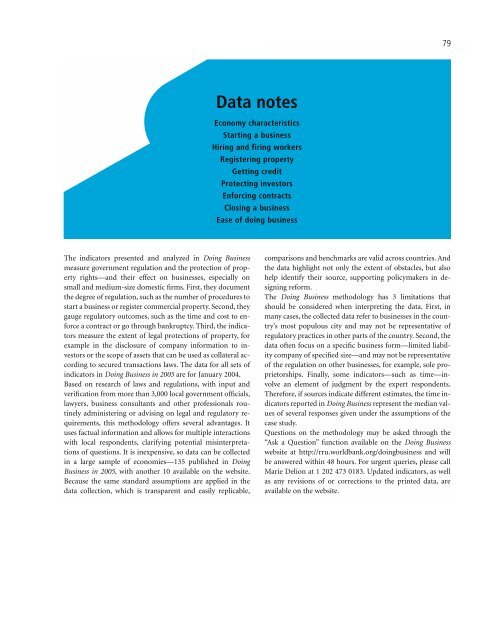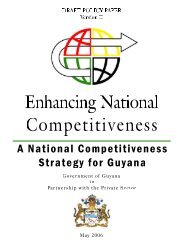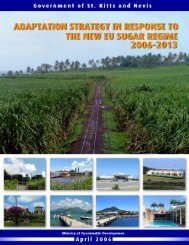Business Removing
Doing Business in 2005 -- Removing Obstacles to Growth
Doing Business in 2005 -- Removing Obstacles to Growth
- No tags were found...
Create successful ePaper yourself
Turn your PDF publications into a flip-book with our unique Google optimized e-Paper software.
79<br />
Data notes<br />
Economy characteristics<br />
Starting a business<br />
Hiring and firing workers<br />
Registering property<br />
Getting credit<br />
Protecting investors<br />
Enforcing contracts<br />
Closing a business<br />
Ease of doing business<br />
The indicators presented and analyzed in Doing <strong>Business</strong><br />
measure government regulation and the protection of property<br />
rights—and their effect on businesses, especially on<br />
small and medium-size domestic firms. First, they document<br />
the degree of regulation, such as the number of procedures to<br />
start a business or register commercial property. Second, they<br />
gauge regulatory outcomes, such as the time and cost to enforce<br />
a contract or go through bankruptcy. Third, the indicators<br />
measure the extent of legal protections of property, for<br />
example in the disclosure of company information to investors<br />
or the scope of assets that can be used as collateral according<br />
to secured transactions laws. The data for all sets of<br />
indicators in Doing <strong>Business</strong> in 2005 are for January 2004.<br />
Based on research of laws and regulations, with input and<br />
verification from more than 3,000 local government officials,<br />
lawyers, business consultants and other professionals routinely<br />
administering or advising on legal and regulatory requirements,<br />
this methodology offers several advantages. It<br />
uses factual information and allows for multiple interactions<br />
with local respondents, clarifying potential misinterpretations<br />
of questions. It is inexpensive, so data can be collected<br />
in a large sample of economies—135 published in Doing<br />
<strong>Business</strong> in 2005, with another 10 available on the website.<br />
Because the same standard assumptions are applied in the<br />
data collection, which is transparent and easily replicable,<br />
comparisons and benchmarks are valid across countries. And<br />
the data highlight not only the extent of obstacles, but also<br />
help identify their source, supporting policymakers in designing<br />
reform.<br />
The Doing <strong>Business</strong> methodology has 3 limitations that<br />
should be considered when interpreting the data. First, in<br />
many cases, the collected data refer to businesses in the country’s<br />
most populous city and may not be representative of<br />
regulatory practices in other parts of the country. Second, the<br />
data often focus on a specific business form—limited liability<br />
company of specified size—and may not be representative<br />
of the regulation on other businesses, for example, sole proprietorships.<br />
Finally, some indicators—such as time—involve<br />
an element of judgment by the expert respondents.<br />
Therefore, if sources indicate different estimates, the time indicators<br />
reported in Doing <strong>Business</strong> represent the median values<br />
of several responses given under the assumptions of the<br />
case study.<br />
Questions on the methodology may be asked through the<br />
“Ask a Question” function available on the Doing <strong>Business</strong><br />
website at http://rru.worldbank.org/doingbusiness and will<br />
be answered within 48 hours. For urgent queries, please call<br />
Marie Delion at 1 202 473 0183. Updated indicators, as well<br />
as any revisions of or corrections to the printed data, are<br />
available on the website.

















